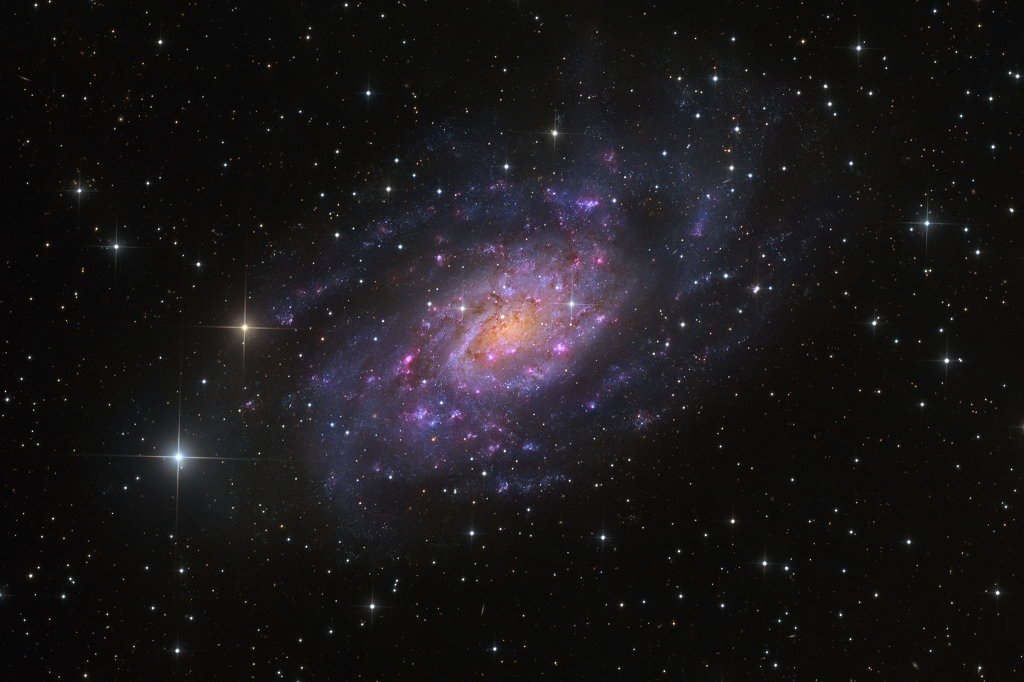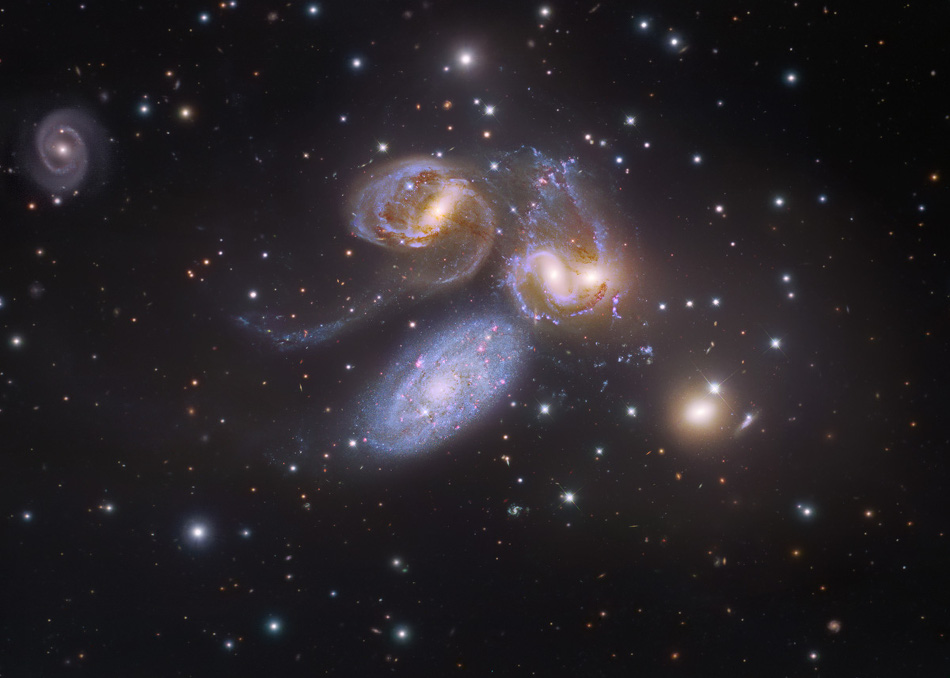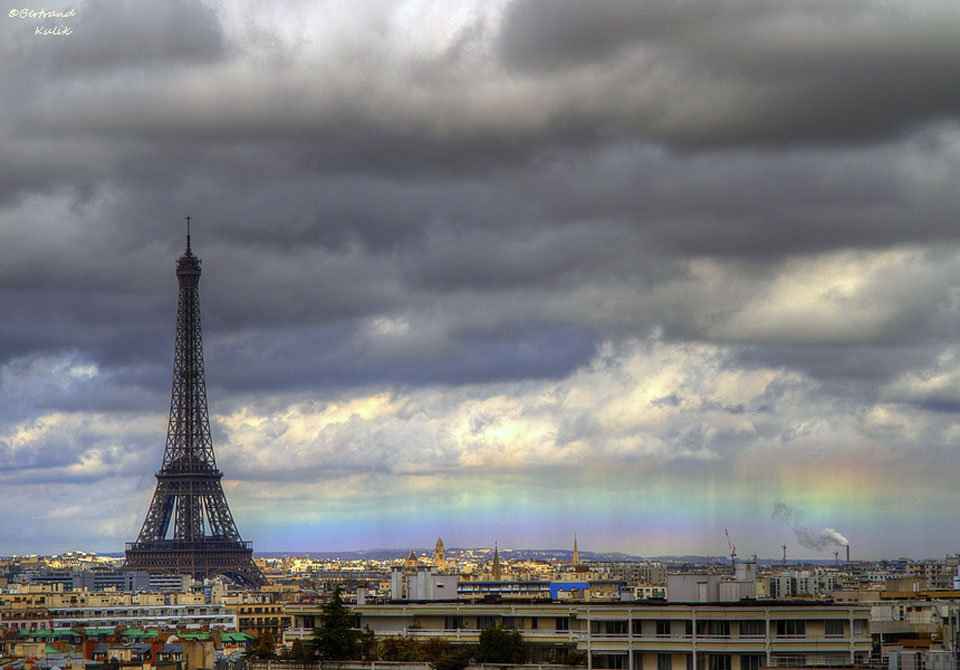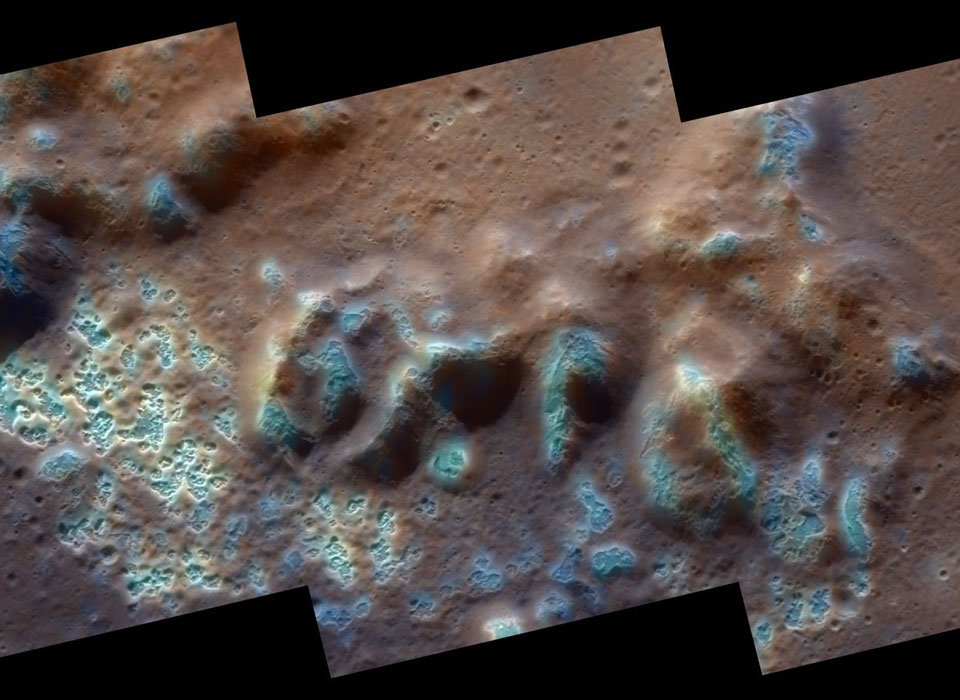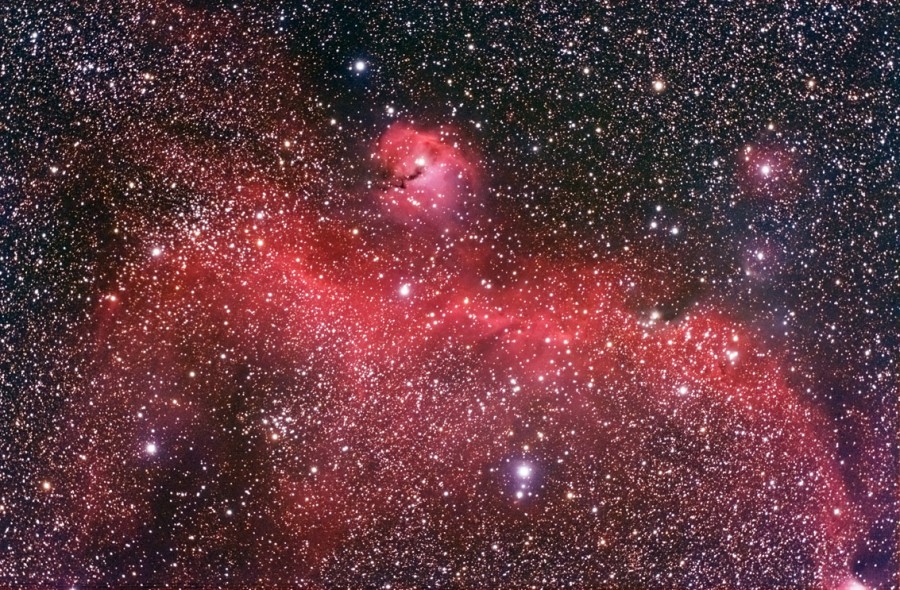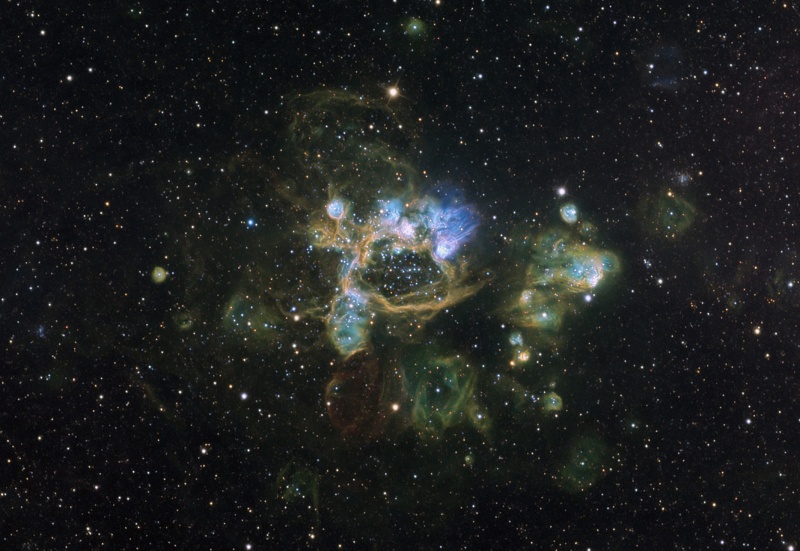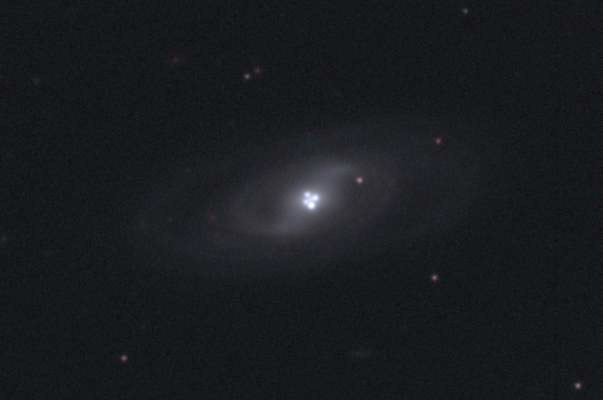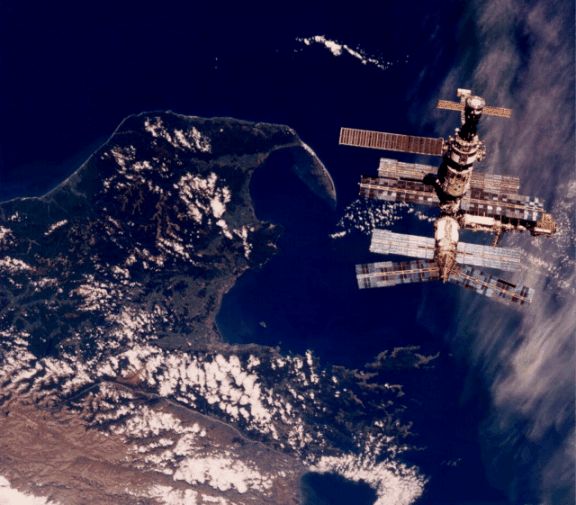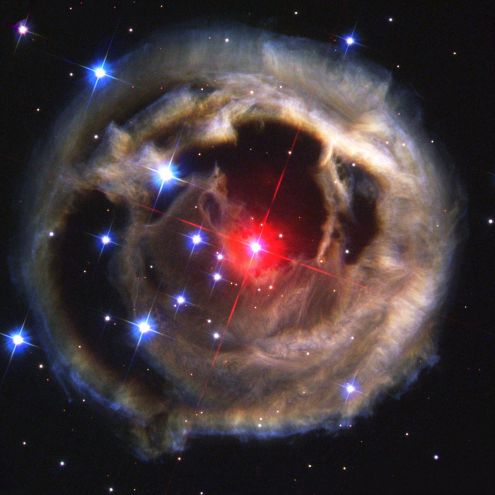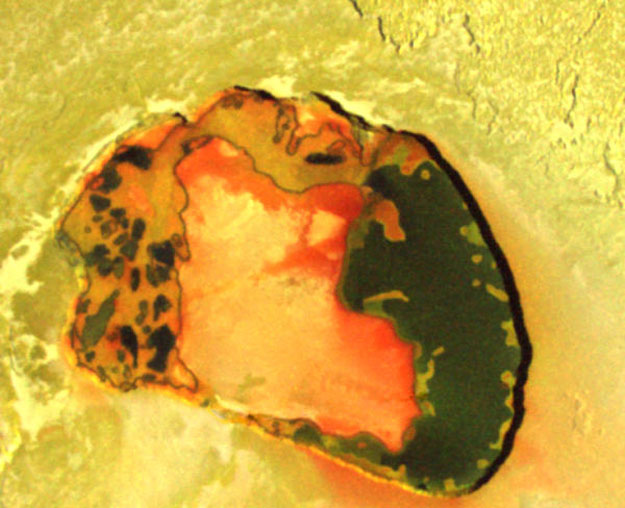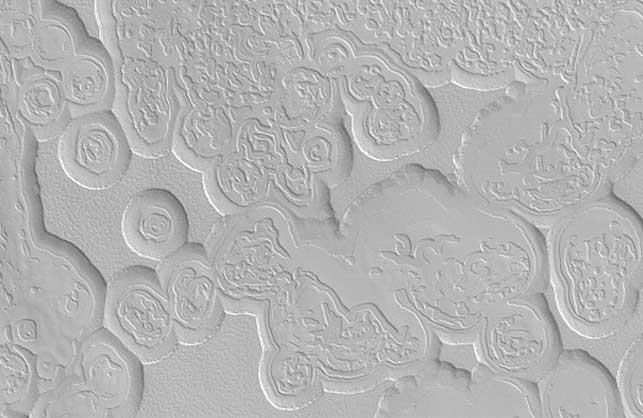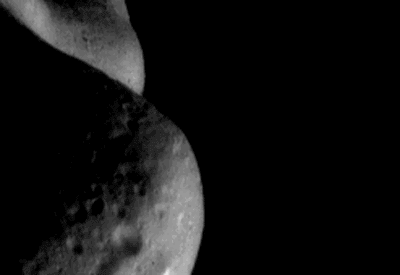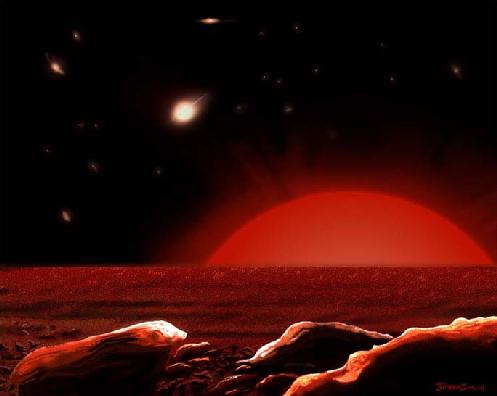| << Previous | Index | Next >> |
2015 Magnificent island universe NGC 2403 stands within the boundaries of the long-necked constellation Camelopardalis. Some 10 million light-years distant and about 50,000 light-years across, the spiral galaxy also seems to have more than its fair share of giant star forming HII regions, marked by the telltale reddish glow of atomic hydrogen gas. The giant HII regions are energized by clusters of hot, massive stars that explode as bright supernovae at the end of their short and furious lives. A member of the M81 group of galaxies, NGC 2403 closely resembles another galaxy with an abundance of star forming regions that lies within our own local galaxy group, M33 the Triangulum Galaxy. Spiky in appearance, bright stars in this colorful galaxy portrait of NGC 2403 lie in the foreground, within our own Milky Way.
2014
2013 Why is this horizon so colorful? Because, opposite the Sun, it is raining. What is pictured above is actually just a common rainbow. It's uncommon appearance is caused by the Sun being unusually high in the sky during the rainbow's creation. Since every rainbow's center must be exactly opposite the Sun, a high Sun reflecting off of a distant rain will produce a low rainbow where only the very top is visible -- because the rest of the rainbow is below the horizon. Furthermore, no two observers can see exactly the same rainbow -- every person finds themselves exactly between the Sun and rainbow's center, and every observer sees the colorful circular band precisely 42 degrees from rainbow's center. The above image featuring the Eiffel Tower was taken in Paris, France last week. Although the intermittent thunderstorms lasted for much of the day, the horizon rainbow lasted for only a few minutes.
2012 What are those unusual features on planet Mercury? The slightly bluish tinge of features dubbed hollows has been exaggerated on the above image by the robotic MESSENGER spacecraft currently orbiting Mercury. The rounded depressions appear different than impact craters and nothing like them has been noted on Earth's Moon or anywhere else in the Solar System. The above image is a section of the floor of Raditladi impact basin about 40 kilometers wide that includes the mountains of the central peak. One progenitor hypothesis is that the hollows formed from the sublimation of material exposed and heated during the violent impact that created the Raditladi basin. NASA's MESSENGER is the first spacecraft ever to orbit Mercury, and is currently scheduled to explore the Solar System's innermost planet into 2013.
2011 The largest canyon in the Solar System cuts a wide swath across the face of Mars. Named Valles Marineris, the grand valley extends over 3,000 kilometers long, spans as much as 600 kilometers across, and delves as much as 8 kilometers deep. By comparison, the Earth's Grand Canyon in Arizona, USA is 800 kilometers long, 30 kilometers across, and 1.8 kilometers deep. The origin of the Valles Marineris remains unknown, although a leading hypothesis holds that it started as a crack billions of years ago as the planet cooled. Several geologic processes have been identified in the canyon. The above mosaic was created from over 100 images of Mars taken by Viking Orbiters in the 1970s.
2010 Stark shadows of mountains and crater walls stand out along the lunar terminator, or shadow line between night and day, in this telescopic image. Of course, if viewed from the lunar surface near the terminator line, the Sun would be rising and still close to the lunar horizon. But the picture's inset at the left highlights a more elusive lunar sunrise phenomenon. Streaming through a gap in the eastern wall of 45 kilometer wide Hesiodus crater, the low-angle sunlight produces a long sunrise ray playing along the otherwise shadowed crater floor. Sunrise rays are short-lived and can be rewarding to spot for Moon enthusiasts with telescopes. Seen in Hesiodus and other craters, the ray timing can be calculated based on the observer's location. This picture of a first quarter Moon was recorded at 23:45 UT on February 22nd from Stuttgart, Germany. In the inset, the larger crater Pitatus is at the right. For location, Hesiodus and Pitatus are circled at the bottom of the picture.
2009 Images from two different cameras, a digital SLR and an astronomical CCD camera, are combined in this color starscape. Both cameras made use of the same telescope at the oceanside Winter Star Party in the Florida Keys, appropriately creating this portrait of the Seagull Nebula. The wide view covers a 4x3 degree swath across the plane of the Milky Way, near the direction of Sirius, alpha star of the constellation Canis Major. Of course, the broad region includes objects with other catalog designations: notably NGC 2327 - a compact, dusty emission region with an embedded massive star that forms the bird's head (above center), and IC 2177 - forming the sweeping arc of the seagull's wings. Dominated by the reddish glow of atomic hydrogen, the complex of cosmic gas and dust clouds with bright young stars spans over 250 light-years at an estimated 3,800 light-year distance.
2008 A truly giant complex of emission nebulae, N44 is about 1,000 light-years across. It shines in southern skies as a denizen of our neighboring galaxy, the Large Magellanic Cloud, 170,000 light-years away. Winds and intense radiation from hot, young, luminous stars in N44 excite and sculpt filaments and streamers of the glowing nebular gas. But supernovae - the death explosions of the massive short lived stars - have also likely contributed to the region's enormous, blown-out shapes. The cluster of young stars seen near the center lies in a superbubble nearly 250 light-years across. This detailed, false-color view of the intricate structures codes emission from hydrogen, oxygen, and sulfur in shades of blue and green.
2007 The active moon Enceladus appears to be making Saturn's E ring. An amazing picture showing the moon at work was taken late last year by the Saturn-orbiting Cassini spacecraft and is shown above. Enceladus is the dark spot inside the bright flare, right near the center of Saturn's E ring. Streams of ice and water vapor can be seen pouring off Enceladus into the E ring. The above bright image of the normally faint E-ring was made possible by aligning Cassini so that Saturn blocked the Sun. From that perspective, small ring particles reflect incoming sunlight more efficiently. Cassini has now been orbiting Saturn for almost three years, and is scheduled to swoop by the unexpectedly cryovolcanic Enceladus at least several more times.
2006 Why are there so many moonquakes? A recent reanalysis of seismometers left on the moon by the Apollo moon landings has revealed a surprising number of moonquakes occurring within 30 kilometers of the surface. In fact, 28 moonquakes were detected in data recorded between 1972 and 1977. These moonquakes were not only strong enough to move furniture but the stiff rock of the moon continued vibrating for many minutes, significantly longer than the soft rock earthquakes on Earth. The cause of the moonquakes remains unknown, with one hypothesis holding that landslides in craters cause the vibrations. Regardless of the source, future moon buildings need to be built to withstand the frequent shakings. Pictured above in 1969, Apollo 11 astronaut Buzz Aldrin stands besides a recently deployed lunar seismometer, looking back toward the lunar landing module.
2005 Most galaxies have a single nucleus -- does this galaxy have four? The strange answer leads astronomers to conclude that the nucleus of the surrounding galaxy is not even visible in this image. The central cloverleaf is rather light emitted from a background quasar. The gravitational field of the visible foreground galaxy breaks light from this distant quasar into four distinct images. The quasar must be properly aligned behind the center of a massive galaxy for a mirage like this to be evident. The general effect is known as gravitational lensing, and this specific case is known as the Einstein Cross. Stranger still, the images of the Einstein Cross vary in relative brightness, enhanced occasionally by the additional gravitational microlensing effect of specific stars in the foreground galaxy.
2004 This dream-like image of Mir was recorded by astronauts as the Space Shuttle Atlantis approached the Russian space station prior to docking during the STS-76 mission. Sporting spindly appendages and solar panels, Mir resembles a whimsical flying insect hovering about 350 kilometers above New Zealand's South Island and the city of Nelson near Cook Strait. In late March 1996, Atlantis shuttled astronaut Shannon W. Lucid to Mir for a five month visit, increasing Mir's occupancy from 2 to 3. It returned to pick Lucid up and drop off astronaut John Blaha during the STS-79 mission in August of that year. Since becoming operational in 1986, Mir has been visited by over 100 spacefarers from the nations of planet Earth including, Russia, the United States, Great Britain, Germany, France, Japan, Austria, Kazakhstan and Slovakia. After joint Shuttle-Mir training missions in support of the International Space Station, continuous occupation of Mir ended in August 1999. The Mir was deorbited in March 2001.
2003 Nominated for most mysterious star in the Milky Way, V838 Monocerotis briefly became one of the brightest stars in our galaxy. Its outburst discovered in January 2002, observations have indicated that V838 Mon somehow transformed itself over a period of months from a small under-luminous star a little hotter than the Sun, to a highly-luminous, cool supergiant star -- defying the conventional understanding of erupting stars and stellar life cycles. In this spectacular image, one of a series recorded last year by the Hubble Space Telescope, the dimmed V838 Mon is surrounded by an "expanding" nebula. But the nebula is actually a series of light echoes from formerly unseen shells of dust up to light-years in diameter. Previously ejected, the intricate shells progressively reflect light as it reaches them from V838 Mon's outbursts. Astronomers anticipate that light echoes from farther out in the dust envelope will continue to be visible until about 2010. Some estimates now place V838 Mon about 20,000 light-years from planet Earth.
2002 What would it look like to peer into one of the volcanoes currently active on Jupiter's moon Io? The caldera of Tupan Patera, named after a Brazilian thunder god, reveals itself to be a strange and dangerous place, replete with hot black lava, warm red sulfur deposits likely deposited from vented gas, and hilly yellow terrain also high in sulfur. The robot spacecraft Galileo currently orbiting Jupiter provided the above vista late last year when it swooped by the active world. Tupan Patera is actually a volcanic depression, surrounded by cliffs nearly a kilometer high. The width of the depression is about 75 kilometers. As Galileo has filled its mission objectives and is running low on maneuvering fuel, NASA plans to crash the spacecraft into Jupiter during 2003.
2001 Why do parts of the south pole of Mars look like swiss cheese? This little-understood landscape features flat-topped mesas nearly 4 meters high and circular indentations over 100 meters across. Since this swiss-cheese topography is unique to the polar cap covering southern Mars, exogeologists speculate that mesa composition might be high in frozen carbon dioxide (dry ice). Additionally, dry ice might have had a role in this strange landscape's creation. In the above picture, the Martian surface is illuminated by sunlight from the upper right. The above picture was taken in August 1999 by the robot Mars Global Surveyor spacecraft currently orbiting Mars.
2000 What would it look like to fly over an asteroid? Spacecraft NEAR Shoemaker in orbit around asteroid 433 Eros found out earlier this month when it recorded its first fly-over sequence. The saddle region of the Sun-orbiting space-mountain appears to zip past the camera in this condensed hour-long time-lapse sequence. The spacecraft was orbiting about 200 kilometers above the asteroid. Movies such as this are scientifically useful for discerning between regions that are naturally dark and regions that have their brightness dominated by shadows. The week before, a bright X-ray burst from the Sun allowed NEAR's X-ray spectrometer to detect the presence of several elements on Eros' surface by their X-ray fluorescent signatures.
1999
1998 Why is the Moon dusty? On Earth, rocks are weathered by wind and water, creating soil and sand. On the Moon, the long history of micrometeorite bombardment has blasted away at the rocky surface creating a layer of powdery lunar soil or regolith. This lunar regolith could be a scientific and industrial bonanza. But for the Apollo astronauts and their equipment, the pervasive, fine, gritty dust was definitely a problem. On the lunar surface in December 1972, Apollo 17 astronauts Harrison Schmitt and Eugene Cernan needed to repair one of their lunar rover's fenders in an effort to keep the "rooster tails" of dust away from themselves and their gear. This picture reveals the wheel and fender of their dust covered rover along with the ingenious application of spare maps, clamps, and a grey strip of "duct tape".
1997 Moonlight illuminates the landscape and lends a painterly quality to this beautiful photograph of the Absaroka mountain range, located along the Montana-Wyoming border near the USA's Yellowstone National Park. In the foreground lies the North Fork of the Shoshone River. The snow-covered peak rising 10,500 feet on the left is Jim Mountain, while Comet Hale-Bopp graces the western sky. Inspired by painters of the American West, like Fredric Remington, Charles Russell, and George "Dee" Smith, photographer Dewey Vanderhoff of Cody, Wyoming has taken advantage of the double blessings of a bright Moon and a bright comet to produce this breathtaking image.
1996 The above true-color photo taken March 25th shows Comet Hyakutake passing below the stars of the Big Dipper. Many astronomy enthusiasts delight in helping people in their local community see the comet. Both Jerry Bonnell and I (RJN) from APOD have been so inclined - both now and when Comet Halley came by in 1986. During these sessions, many good questions are asked and occasionally a humorous situation will arise. One was with a little girl. She waited so patiently for her turn to look through the telescope, hardly able to contain her excitement. Finally her turn came. "Do you see the comet?" I asked. "Wow, wow, WOW!" She beamed. "You see it?" "No." One little boy seemed particularly bent on destruction. "This telescope looks like a big gun," he volunteered. "In some ways, it's even more powerful than a gun," I replied, hoping to challenge his imagination. "Really?" he countered. "Can we shoot down the comet?" "How expensive is the telescope?" is a fairly common question. But one time a real business-person showed up and, possibly feeling particularly affluent, asked "How much is the comet?"
| << Previous | Index | Next >> |
